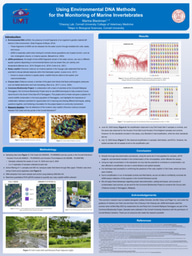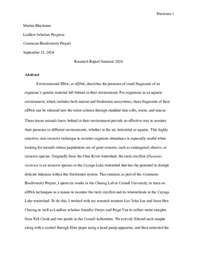Hello! My name is Marina Blackman and I am a fourth year student at Cornell University in Ithaca, New York, USA. At Cornell, I study Biological Sciences with a Marine Biology concentration. This summer, I spent six weeks in Kuala Terengganu, Terengganu, Malaysia participating in Marine Invertebrate Biology research as part of the Laidlaw Leadership and Research Program for my Leadership in Action (LiA) experience. For my LiA, I was a research assistant at Universiti Malaysia Terengganu in the Institute of Tropical Aquaculture and Fisheries (Akuatrop), working alongside fellow Laidlaw Scholar Jennifer Owiyo and under the guidance of Norainy Mohd Husin, Rabi Atun Adawiah Abdullah to contribute to ongoing research for the Commons Biodiversity Project. Driven by collaboration between Biology researchers at Universiti Malaysia Terengganu and Cornell University, the Commons Biodiversity project aims to use environmental DNA (eDNA).
As any kind of organism thrives in its habitat, it is inherently leaving behind traces of its genetic material through things like shedded skin cells, mucus, and waste. The presence of these fragments of an organism’s DNA in aquatic environments can be collected by researchers to identify and track them. Given the unpredictable and costly nature of traditional field surveys, eDNA presents a way to monitor organisms that requires little to no interaction with the organism of interest, and provides increased accuracy with the identification of the organism by using its DNA. These methods for monitoring aquatic organisms can be used to gain a better understanding of their population distributions and confirm their presence if previously identified through visual survey, especially those that are notably shy, rare, elusive, invasive, or cryptic. As a research assistant in Mdm. Norainy’s lab this summer, I was responsible for contributing to eDNA data collection efforts as we worked towards confirming and describing the distributions of two giant clam species endemic to the east coast of Peninsular Malaysia: Tridacna crocea and Tridacna squamosa. In this position, I was able to collect seawater samples from designated sampling sites, filter each sample using a motorized vacuum pump in the lab to trap any suspended genetic material in filter paper, use a DNA extraction kit to provide a smaller volume of any DNA present in the sample at a much higher concentration, use the extracted DNA in Quantitative Polymerase Reaction samples in order to quantify the amount of DNA present in the samples, and use NanoDrop to test the purity of the DNA.
Participating in research at UMT was an incredible way for me to see first-hand the many forms Marine Conservation can take in Terengganu. For instance, on one of our first days at UMT, we had the opportunity to visit AkuaTrop’s hatcheries facility, where they raise different marine species for eventual release into their natural habitat to help their wild populations. Getting to see so many different marine organisms, from Tiger Prawns, to enormous clouds of Clownfish, to a Lion Fish, was so special already, and it was even more exciting to learn from one of the Akuatrop faculty members, Zaidi, about how he takes care of them. Later into our stay, we visited Kampung Cina, Terengganu, where we walked through a well-known attraction there called "Turtle Alley". Walking through Turtle Alley was a really incredible way to not only look at and appreciate the mosaics of turtles that lined the walls, but also learn about the ways in which we could all take action to help the conservation of sea turtles native to the area. As someone who is interested in science communication, I thought this was a really creative, engaging, and immersive way to learn more about how art and storytelling can be used to educate those in the scientific community and the general public about marine conservation. Towards the end of our stay, our mentors took us to visit the Setiu Wetlands and an oyster farm in Kelantan, Malaysia to learn more about the aquaculture practices for harvesting oysters and fish. Each of these experiences allowed me to deepen my understanding of and appreciation for the work that the Commons Biodiversity Project does, and recognize who was engaging in these discussions and efforts with UMT researchers to help conserve marine life in the area.
While this internship experience provided me with opportunities to learn more about Marine Conservation and Terengganu, I was also able to learn more about myself in the process. Through my LiA experience, I have learned how well I can adapt to change when I take the time to plan carefully ahead of time and ask for help. Traveling from the east coast of the US to Kuala Terengganu, about a 25-hour journey in total, was definitely daunting, as this would be the farthest I had ever traveled without my family. However, working with Jennifer and our faculty mentors to develop detailed plans for not only how we would approach our research this summer, but also travel logistics, really helped me learn more about the area I would be traveling to, and what the process of traveling there would be like, which ultimately reduced my feelings of intimidation towards such a big international trip. As part of this planning, my mentors also encouraged me to think ahead about how I could navigate my dietary restrictions while in Terengganu too.
Despite my excitement about this opportunity to travel to another country, learn more about a culture that is unfamiliar to me, and engage in hands-on Marine Biology lab and fieldwork, having grown up with several food allergies, I could not help but feel nervous about the food options I would have there and while traveling, as my research mentors had mentioned the prevalence of seafood, peanuts, and tree nuts in Malaysian cuisine. However, taking steps such as reading online about the experiences others have had travelling to Southeast Asia with allergies similar to mine, researching popular dishes in Malaysian cuisine and their ingredients, and carefully planning out quick meals I could cook for myself helped me feel much more prepared to navigate my food options in Terengganu and make sure that I am eating enough and safely. Although I get very anxious about eating with my food allergies, I found that once I dedicate time to expanding my knowledge about something and being very organized about collecting this information through my own research, I can readily apply new things I have learned to prepare for new experiences and adapt well to change! It is so important to highlight here that my navigation of dining options in Terengganu would not have been possible if I had not asked for help or expressed concern about it in the first place. The support and guidance I received from Jennifer and my faculty mentors Lee Yoke Lee, Ain, Rabi, and Yusri, helped me immensely in overcoming the anxiety I was feeling around eating in Terengganu, and for that I am so grateful!
My time as a research assistant for the Commons Biodiversity Project has been characterized by the consistent reinforcement of how crucial communication and the formation of strong, meaningful connections with those around you can be when taking on exciting, but sometimes also challenging or intimidating new experiences. When looking back on my involvement in this project through a scientific lens, I of course think about gaining skills in lab and field work, studying incredible organisms, getting to explore the Marine Biology programs of a different institution once unfamiliar to me, and visiting various sites and stations focused on wildlife conservation. At the same time, I can’t help but also reflect on and appreciate the opportunities we had throughout this experience to meet incredibly driven and kind marine scientists, researchers, students, and locals outside of the university, gain immersive, hands-on experience with marine conservation both in and outside of the lab with their guidance, learn more about Malaysian history and culture, and explore the many facets of marine conservation, what it looks like, and who is involved. Science, understanding, collaboration, and the forging of strong bonds with those in your community are all so closely intertwined, and that is something I will always carry with me as a Marine Biologist and as a person.



Please sign in
If you are a registered user on Laidlaw Scholars Network, please sign in